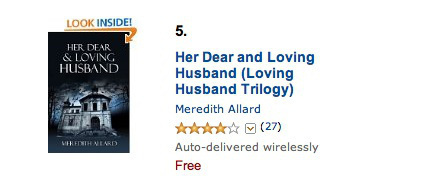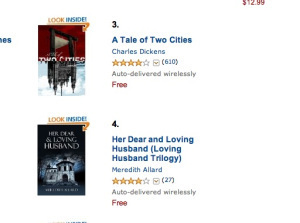The Fifty Shades of Grey phenomenon has sparked some interesting conversations about writing quality and how well an author needs to write in order to produce a best-seller. This is hardly a news-worthy debate. I remember the same questions when Bridges of Madison County was selling like crazy. I remember it again when The DaVinci Code was on the best-seller lists. I heard it again when Twilight-Mania overtook girls and women all around the world.
A few weeks ago, as I was reading Joanna Penn’s wonderful The Creative Penn blog, I saw this interesting post about deciding whether she wanted to be a best-selling or a best-writing author. In her post, Joanna talks about the difference between books that are lauded as literary masterpieces but don’t make waves with readers and therefore don’t sell well and the books that aren’t considered literature or even particularly well-written but sold millions of copies. She has a point. There are authors whose cerebral style makes their stories and their characters detached and inaccessible. More than anything, people want to feel connected to the stories they read and the characters who inhabit them. Joanna’s conclusion? She’d rather be a best-selling author.
Best-selling certainly sounds cool, especially since I’m writing this in the glow of some good Amazon news: Amazon set Her Dear & Loving Husband to free, and as of my last check, it was #5 on the historical fiction list, #12 for literary fiction, and #190 overall. If you have a Kindle, by all means, enjoy a free copy. I even took a screen shot because I was so excited. After all, writers write because we want our stories read, and being a best-selling author means a lot of people have read your story—or at least bought it—or downloaded it—or whatever. It means a lot of people, okay?

But what do I want to achieve as a writer? What do I really want to achieve? I have a more literary style than other writers, which can work for or against me, I know, but it’s who I am. It’s my uniqueness. My fingerprint. I’ve had it, apparently, since college when professors and other students would comment on my literary style. The truth is I’m a frustrated poet, and while I’m not wise enough to write poetry, I can use the elements of poetry I love to create my own style of prose. John Forster, Charles Dickens’ good friend, biographer, and beta reader (yes, they had beta readers in the 19th century, they just didn’t have the name), used to point out to Dickens his tendency to fall into blank verse during the more emotional moments of his stories. I have the same tendency, though I don’t think it’s a bad thing. It gives a certain flow to the prose.
Language matters to me. How words string together into sentences, paragraphs, pages, and chapters matters to me. I will spend a half hour on a single sentence trying it with the comma here, the comma there, the comma in another sentence, no commas anywhere ee cummings-style. And being a teacher who often reads out loud to my students, I’m keenly aware of the flow of words, and I want my writing to sound as good read aloud as it does in the reader’s mind. That’s not easy, and it takes a lot of fine-tuning. My main challenge writing poetry-inspired prose is to keep my characters and their stories accessible to my reader. It’s okay for the language to be pretty as long as the reader can follow along, and, more importantly, care about what’s happening.
When I had Her Dear & Loving Husband critiqued in 2010, the critiquer, a romance novelist, suggested I leave out the more literary flights of fancy. She wanted me to leave out “The hunt, the hunter, the hunted…” passage, and she thought the scene between James and his father, where the father’s unconditional love shines through, could go. She wasn’t sure about Geoffrey, but then again no one’s sure about Geoffrey. She wanted me to turn my English professor James into an alpha-male, and she wanted more explicit sex scenes. In other words, she wanted me to turn it into a traditional romance. She pointed out that romance readers expect their books to be a certain way, and since she’s the award-winning romance writer I have no doubt she’s right. I took a lot of her advice, but the literary passages stayed. The poetry stayed. James, his tender, loving nature, stayed. Geoffrey…well, you know Geoffrey. He wouldn’t go away even if I asked him to. I knew I was taking a chance by not adhering to conventions, but I had to write my book the way I had to write it. My style, for its strengths and weakneses, is mine, and I wouldn’t change it to conform to the expectations for a romance novel. I knew I might lose readers because of it, so I had to decide that that was okay with me. I didn’t feel right making changes I didn’t believe in because “this is the way these types of books are written.”
Whenever I skim my own book reviews at Amazon or BN and see the ones that say, “This wasn’t what I expected, and I was surprised by how much I liked it,” I smile. I know my style isn’t everyone’s cup of tea, but I don’t mind. There are readers out there who do like it, and I’ve received the most lovely e-mails any author can hope for from people who get my stories, crazy-style and all.
In the end, did I decide I wanted to be a best-selling or a best-writing author? I’d like to be both, please. I still think it’s possible to write a story that readers will enjoy while taking care with the style of the language. That’s what writing is, isn’t it?
Addendum: I’m trying not to be OCD about checking my Amazon stats, but I have to admit it’s a tough battle because it’s so much fun. I just peeked again, and Her Dear & Loving Husband is now #9 in literary fiction, #94 overall, and #4 in historical fiction. What’s number 3 in historical fiction? Charles Dickens’ A Tale of Two Cities. Those of you who know how much I love Dickens can guess what it means to me to see my book next to his on the best-seller list.

Filed under:
Writing Tagged:
Amazon,
BN,
Her Dear & Loving Husband,
writing








 newest »
newest »
 newest »
newest »
 You go girl!! You deserve it! Nothing like schmoozing on the Amazon list with literary royalty!! You don't see 'other' books doing that, do you??!! Stuff that in your backpack folks!! Yeah for good literature!!!
You go girl!! You deserve it! Nothing like schmoozing on the Amazon list with literary royalty!! You don't see 'other' books doing that, do you??!! Stuff that in your backpack folks!! Yeah for good literature!!!














